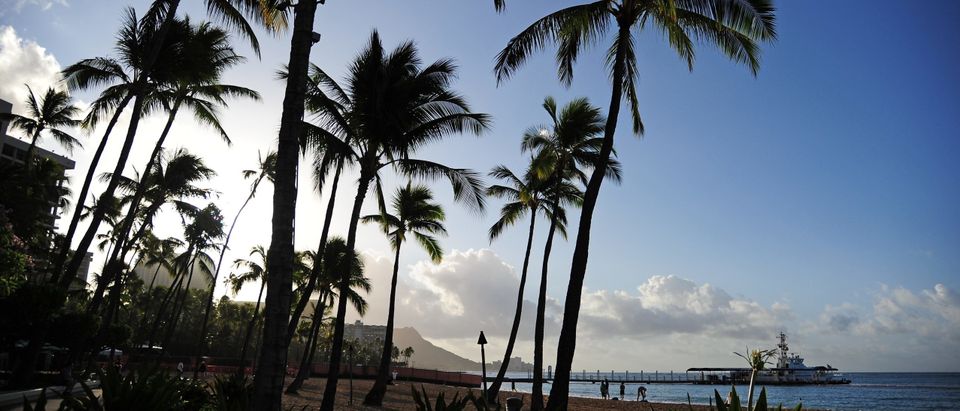The pandemic has wrought economic turmoil throughout the United States, but it has been especially tough on the state of Hawaii given its reliance on tourism.
The dramatic pandemic lockdowns and travel restrictions have worsened income inequality, homelessness and will likely worsen government dependence in the long term due to economic suffering among Hawaii residents, according to a Monday report from The American Conservative.
Tourism accounted for almost a quarter of the state’s economy pre-pandemic, Hawaii Public Radio reported. But coronavirus has largely put tourism and travel on hold for the past year, wrecking Hawaii’s economy. Despite lowering (but still rather high) levels of unemployment, experts think that Hawaii’s economic woes could linger or worsen, especially in terms of homelessness.
After Hawaii was granted statehood in 1959, Frommer’s says tourism to Hawaii increased thanks to the arrival of the first jet airliners to the state, which brought 250,000 tourists to the state that year. Since then, the tourism industry in Hawaii has exploded.
Hawaii has consistently had among the highest unemployment rates in the country during the pandemic – Maui in particular has been hit hardest, with tourism industry suffering – Now, Maui County is hosting drive thru job fair Tuesday @KITV4 >> https://t.co/GjGoJhpafF
— Tom George (@TheTomGeorge) April 18, 2021
Hawaii hosted nearly 10.5 million tourists in 2019, a 5.4% increase from 2018, a figure The Pacific Business News claimed was the highest number ever recorded. The Hawaii Tourism Authority said that these visitors spent $17.75 billion in 2019, with average daily spending of $48.6 million ($195 per visitor). This economic activity generated $2.07 billion of state tax revenue in 2019, and supported 216,000 jobs for the state’s population of just over 1.4 million.
But the last year has told a very different story, as tourism worldwide came to a grinding halt.
On March 21, Democratic Hawaii Gov. David Y. Ige issued an order that required people arriving from out of state to self-quarantine for two weeks, the first of such an order instituted by a state in the U.S., according to NPR. The government-imposed quarantine coupled with the initial fears over air travel during COVID-19 caused tourist arrivals to crater.
While in 2019, 30,000 people were touching down in tropical paradise (nearly 40,000 during peak tourist season), NPR reported that daily arrivals dropped to below 500 during the spring of 2020.
Between March 1 and March 27, 2020, 97,000 new unemployment claims were filed in the state, Hawaii Public Radio reported at the time. Scott Murakami, director of the State Department of Labor and Industrial Relations for Hawaii told Hawaii Public Radio that the state “received 20,041 new filings” on March 24 alone. Those 20,000-plus claims were more than the approximately 19,000 total number of statewide unemployed in 2019, according to Hawaii Public Radio.
If you look out the windows from the upper, most expensive floors, you can see the ocean and sand but not the now tiny homeless people. They become invisible if you’re rich enough. What did you think runaway economic inequality was going to do to us? https://t.co/neEb2ieSQy
— The American Conservative (@amconmag) April 19, 2021
Hawaii Public Radio also reported that Hawaii’s Department of Labor increased its number of staff to process claims from seven to 45 in order to keep pace with the skyrocketing number of claims in the early days of the pandemic.
These skyrocketing unemployment claims came predominantly from hospitality and restaurant workers, and the statewide unemployment rate reached nearly 24% — almost Great Depression levels — in April and May of 2020, NPR reported.
By October 2020, employment conditions had somewhat improved, but nearly one in six workers were still out of work. The U.S. Bureau of Labor Statistics found that in October 2020, Hawaii’s unemployment rate was the highest in the nation at 14.3%, an 11.6% increase compared to October 2019’s 2.7% unemployment rate. (RELATED: Hawaiian Officials Cite Dozens of Tourists Climbing Active Volcano For Selfies)
Last week, The Hawai’i State Department of Labor & Industrial Relations (DLIR) announced that its unemployment rate has since declined to 9%, down 0.2% compared to February.
Experts fear that Hawaii’s unsheltered homeless population will continue to increase even if the pandemic’s worst days are behind it.
“After the last recession in Hawaii, homelessness increased in Hawaii by 2,100 people during that seven-year period between 2009 and 2016. It was a nearly 37% increase,” Scott Morishige, Ige’s coordinator on homelessness, told Hawaii legislators at a hearing in January, according to the Hawaii Tribune Herald. “It’s likely that any future increase that we see as a result of the current economic impact … related to the pandemic is going to result in a similar increase that’s not just a onetime spike, but is going to occur gradually over a longer period of time, and probably on a greater level of magnitude than what we had encountered previously.”












